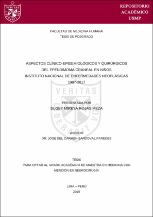Aspectos clínico-epidemiológicos y quirúrgicos del ependimoma craneal en niños Instituto Nacional de Enfermedades Neoplásicas 1987-2017

View/
Download
(application/pdf: 2.184Mb)
(application/pdf: 2.184Mb)
Date
2019Author(s)
Rojas Meza, Sugey Mireya
Metadata
Show full item recordAbstract
Objective: To describe the clinical-epidemiological and surgical aspects of intracranial ependymoma in children of age in the National Institute of Neoplastic Diseases between 1987-2017.
Methodology: It is an observational study that was carried out between 1987-2017, considering 53 children operated on intracranial ependymoma at the National Institute of Neoplastic Diseases.
Results: 53 patients were identified, 47.2% were women and 52.8% were male. In multislice spiral tomography and / or brain magnetic resonance imaging it was found that 58.5% had location at the infratentorial level and in 41.5% supratentorial. All 31 patients with tumor with infratentorial location presented hydrocephalus at the time of admission and all were placed peritoneal ventricular bypass in the preoperative period. Total tumor resection was performed in 47.2% and subtotal in 52.8%. They received 45 radiotherapy patients and it was 40 Gys to the total skull, 35 Gys to the entire spine and an additional boost to the operating bed of 15 Gys. From 1984 to 1996 all patients received radiotherapy and from 1997 only local radiotherapy in grade II ependymoma and currently only to anaplastic ependymomas. Only 15% received chemotherapy. 75.5% had no metastases, only 3.8% intraspinal and 20.7% is unknown.
Conclusions: Here were no differences in men and women. CT and MRI of the brain found that 58.5% of the cranial ependymomas had localization at the infratentorial level and 41.5% supratentorial. The infratentorial location presented hydrocephalus at the time of admission and a peritoneal ventricular shunt was placed in the preoperative period at 83.8%. They had total surgical resection 47.2% and subtotal in 52.8%. 15% received chemotherapy for being under three years old. Cranial recurrence in grade II in 56% and in grade III 71.4%. 3.8% presented spinal metastases. The survival of the cranial ependymoma in children at 3, 5 and 10 years is 91%, 82% and 41% respectively, unlike the anaplastic ependymoma at 3, 5, 10 years is 74%, 52% and 0%.
Collections
- Tesis de maestría [562]







